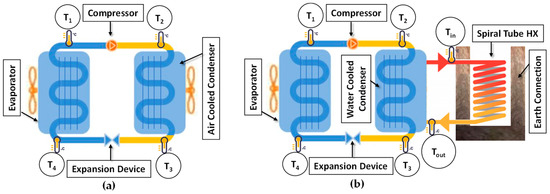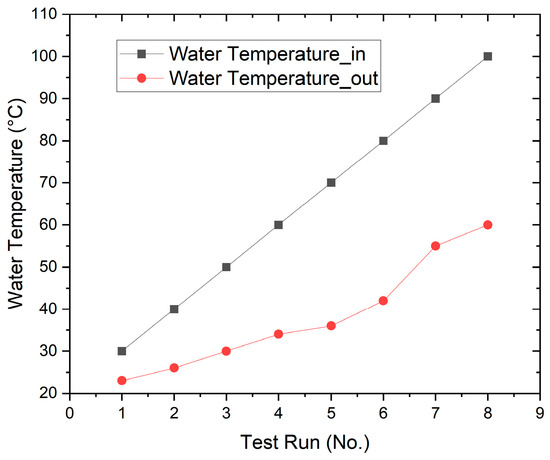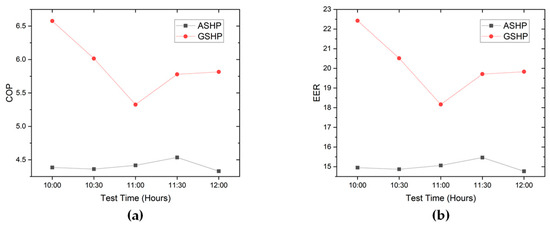Abstract
Vertical borehole geothermal heat pumps (GHPs) offer eco-friendly and energy-efficient heating and cooling. This paper proposes enhancing the coefficient of performance (COP) by converting air source heat pumps (ASHPs) into ground source heat pumps (GSHPs). This study presents a cost-effective approach to utilizing existing water boreholes in Pakistani buildings, reducing drilling and piping expenses. The results show that GSHPs achieved average COP values of 5.92, 33.33% higher than ASHPs. GSHPs demonstrated an average energy efficiency ratio (EER) of 20.12, exceeding ASHPs by 33.9%. These findings highlight the enhanced COP and energy efficiency of GSHPs, making them an attractive option for sustainable HVAC systems.
1. Introduction
Geothermal heat pumps (GTHPs) have emerged as a promising alternative to conventional heating and cooling systems, demonstrating great potential for sustainable development and contributing to the attainment of sustainable development goals (SDGs). The energy-intensive nature of heating, ventilating, and air-conditioning (HVAC) systems in residential buildings raises concerns about their reliance on fossil fuels and their associated environmental impacts. Consequently, there is a growing initiative to replace conventional HVAC systems with environmentally friendly alternatives. Ground source heat pumps (GSHPs) have gained considerable attention as a sustainable solution, leveraging the Earth’s stable thermal properties to provide energy-efficient heating and cooling. By tapping into renewable energy stored in the ground, GSHPs offer advantages such as higher energy efficiency and reduced greenhouse gas emissions.
S. Zhang et al. conducted a study on the performance evaluation of five residential GSHP systems in a region that experienced hot summers in China. The study revealed that the heat pumps exhibited an average coefficient of performance (COP) ranging from 3.36 to 5.94, while the system’s energy efficiency ratio (EER) varied between 1.95 and 4.35 [1]. In another investigation, J. Luo et al. continuously monitored a GSHP system that had been installed in an office building in Germany for four years. The results indicate an annual increase of 8.7% in the system’s seasonal energy efficiency Ratio (SEER), while the seasonal COP exhibited a decrease of 4.0% [2].
Y. Hwang et al. presented a study focused on the cooling performance of a closed vertical-type ground heat exchanger with 24 boreholes, each 175 m deep, installed in a school building in Korea. The study reported an average cooling COP of 8.3 and an overall COP of 5.9. In comparison, the air source heat pump (ASHP) system, with an equivalent capacity, exhibited an average COP of 3.9 and an overall COP of 3.4. These findings suggest that the GSHP system outperforms the ASHP system due to the Earth’s stable and lower temperatures [3].
This research paper focuses on investigating the performance of GSHPs in cooling applications in Pakistan. The study aims to compare COP and EER of a conventional ASHP with a heat pump that has been converted to utilize a vertical bore ground-cooled condenser.
2. Experimental Methodology
The experimental methodology employed in this study was used to assess the performance and feasibility of a GSHP system. The first step involved determining the undisturbed ground temperature at a depth of 30–50 feet, as this temperature is crucial for GSHP system design. In this study, the measured ground temperature at the selected site in Sector I-14, Islamabad, Pakistan, was found to be approximately 20 °C.
Soil properties, including thermal conductivity and thermal diffusivity, were examined using the ASTM D5334-14 standard test method. The moisture content of the soil samples was measured to approximate the thermal properties. Gravimetric and sieving methods were employed to determine the grain size and moisture content of the soil as shown in Table 1.

Table 1.
Bore hole soil samples test results.
For the design of the ground connection, the method proposed by Ingersoll et al. [4] was applied, considering a closed-loop ground heat exchanger design. The length of the ground connection was calculated based on the heat transfer equation per unit length. To reduce drilling costs and utilize existing boreholes, a spiral-type ground connection was implemented with a length of approximately 80 feet.
The heat pump selection involved choosing a DC inverter heat pump with a capacity of 1.5 tons operating with refrigerant R-410A, which was then converted into a GSHP. The selection was based on the space heating and cooling loads.
Grouting, an essential aspect of the system, involved filling the space between the ground and the bore casing GI pipe with an appropriate grout material. In this study, the local clay-based mud was identified as the optimal grout material, with an approximate moisture content of 20% and a density of 1600 kg/m3. The determined thermal diffusivity was approximately 0.086 m2/day, while the thermal conductivity of the grout material measured as 2.68 W/m·°C.
The experimental setup included the installation of the ground connection, with winding of 250 ft, 3/8 inch diameter copper tubing on the 5 inch diameter GI bore casing for the fabrication of ground heat exchanger. Temperature sensors were strategically positioned to gather data for the performance evaluation, as illustrated in Figure 1.

Figure 1.
Layout of the experimental setup with sensors placement: (a) ASHP and (b) GSHP.
Data analysis involved operating the original air source heat pump (ASHP) in cooling mode with an indoor set point of 17 °C, collecting temperature, pressure, electric current, and voltage readings at regular intervals of 30 min. The ASHP was then converted into a GSHP by replacing the air-cooled condenser with a water-cooled condenser connected to the ground connection spiral heat exchanger. The GSHP was tested under similar conditions, and data were collected for analysis.
3. Results
The collected data were analyzed to evaluate the performance parameters of the GSHP system, providing valuable insights into its effectiveness compared to ASHP.
Figure 2 presents the temperature results obtained from the ground connection. It is evident that circulating water at eight different inlet temperatures through the ground connection experienced a significant temperature decrease. The temperature difference increased with higher inlet water temperatures, indicating the effectiveness of the heat exchanger.

Figure 2.
Ground connection heat exchanger temperatures for eight test runs in summer.
Figure 3a shows COP of the GSHP and ASHP under identical indoor and outdoor conditions throughout different times of the day during summer in Pakistan. The graph clearly illustrates that the GSHP exhibited a superior COP compared to the ASHP when operating under the same conditions, validating the enhanced performance of the GSHP.

Figure 3.
Comparison of ASHP and GSHP performance: (a) COP and (b) EER.
Similarly, Figure 3b shows a comparison of the EER of both the GSHP and ASHP. The graph demonstrates that the GSHP outperformed the ASHP, mirroring the advantages observed in the COP analysis. The comparable electrical requirements of the ASHP condenser fan and GSHP recirculating pump affirm the analogous trends observed between COP and EER. Since the GSHP utilizes water as a heat carrier, which is more efficient than air, and transfers heat to the ground at approximately 20 °C, the condenser temperatures are lower compared to the ASHP case. Consequently, this results in higher COP and EER values.
4. Conclusions
The experimental results of this study demonstrate significant improvements in the performance of a GSHP compared to an ASHP. The average COP achieved for the GSHP was approximately 5.92, whereas the average COP for the ASHP was found to be 4.44 during operation. This indicates that the GSHP exhibited a COP that was approximately 33.33% higher than ASHP.
Furthermore, the average energy efficiency ratio (EER) for the ASHP was approximately 15.02, whereas the GSHP achieved an average EER of approximately 20.12. Consequently, the EER of the GSHP exceeded that of the ordinary heat pump by approximately 33.9%.
In conclusion, this research highlights the superior performance of geothermal heat pumps in terms of COP and EER compared to conventional heat pumps. The findings emphasize the substantial potential of GSHPs to enhance energy efficiency. Moreover, utilizing an existing water borehole can lead to reduced operating and installation costs.
Future research should focus on assessing GSHPs’ heating capabilities in diverse winter climates and investigating the impact of cooling fluids on ground connections. Additionally, long-term ground temperature monitoring and protective measures against the degradation of the buried heat exchanger are essential.
Author Contributions
Conceptualization, methodology, investigation, data curation, writing—original draft preparation, S.U.; editing, M.I.; review, M.M.K. All authors have read and agreed to the published version of the manuscript.
Funding
This research was funded by ASHRAE, USA, under an undergraduate program equipment grant titled Geothermal Heat Pump.
Institutional Review Board Statement
Not applicable.
Informed Consent Statement
Not applicable.
Data Availability Statement
The data presented in this study are available on request.
Conflicts of Interest
The authors declare no conflict of interest.
References
- Zhang, S.; Zhang, L.; Wei, H.; Jing, J.; Zhou, X.; Zhang, X. Field Testing and Performance Analyses of Ground Source Heat Pump Systems for Residential Applications in Hot Summer and Cold Winter Area in China. Energy Build. 2016, 133, 615–627. [Google Scholar] [CrossRef]
- Luo, J.; Rohn, J.; Bayer, M.; Priess, A.; Wilkmann, L.; Xiang, W. Heating and Cooling Performance Analysis of a Ground Source Heat Pump System in Southern Germany. Geothermics 2015, 53, 57–66. [Google Scholar] [CrossRef]
- Hwang, Y.; Lee, J.K.; Jeong, Y.M.; Koo, K.M.; Lee, D.H.; Kim, I.K.; Jin, S.W.; Kim, S.H. Cooling Performance of a Vertical Ground-Coupled Heat Pump System Installed in a School Building. Renew. Energy 2009, 34, 578–582. [Google Scholar] [CrossRef]
- Kavanaugh, S.; Rafferty, K. Geothermal Heating and Cooling Design of Ground-Source Heat Pump Systems; ASHRAE: Atlanta, GA, USA, 2014. [Google Scholar]
Disclaimer/Publisher’s Note: The statements, opinions and data contained in all publications are solely those of the individual author(s) and contributor(s) and not of MDPI and/or the editor(s). MDPI and/or the editor(s) disclaim responsibility for any injury to people or property resulting from any ideas, methods, instructions or products referred to in the content. |
© 2023 by the authors. Licensee MDPI, Basel, Switzerland. This article is an open access article distributed under the terms and conditions of the Creative Commons Attribution (CC BY) license (https://creativecommons.org/licenses/by/4.0/).